

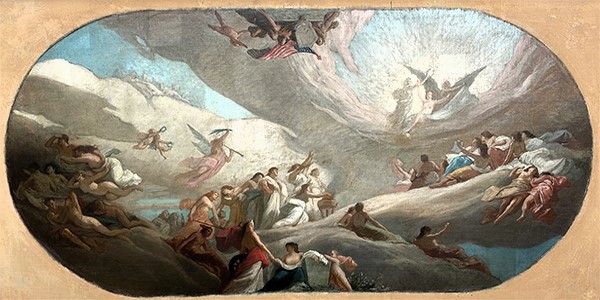
In spring 2023 the Franklin Public Library, site of Tommaso Juglaris’s Grecian Festival mural cycle, as well as Memorial Hall friezes depicting a classical allegory of The Hours, was contacted by a Paris art dealer, Emeric Hahn, alerting library staff to the presence in his gallery of a painting signed and dated by Juglaris in 1905. The painting was obviously a study for a vast ceiling decoration. The dealer, who specializes in the works of French and Italian painters from the seventeenth-to-nineteenth centuries, suggested that it was likely a schema intended by Juglaris for the Franklin Public Library reading room above the sweep of the Grecian Festival murals which adorn all four walls.
In fact, when an image of the Juglaris study was superimposed onto a photograph of the library’s white ceiling with its present decorative oval, it appeared—despite its rounded, oblong shape—well-suited to the space. Yet more than just this appropriate fit seems to validate the suspicion that it was designed and executed as a model for the Franklin Public Library. The 1905 date of the ceiling study coincides with the completion of Juglaris’s other master works at the library. Moreover, as revealed by this preliminary study in oil on canvas, the very style and content of what Juglaris proposed to paint on a vast scale was thoroughly compatible with his already completed Grecian Festival scenes. Had it been ultimately commissioned and executed for the Franklin Public Library, the ambitious ceiling mural thematically celebrating the American nation, complete with a boldly waving Stars and Stripes, would have created a deeper context for appreciating the Grecian Festival murals, already meant to highlight one of the more democratic days in the life of an ancient city.
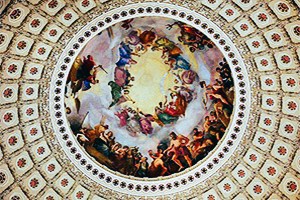
Juglaris’s ceiling plan is not without its affinities to The Apotheosis of George Washington created a half-century earlier by another Italian muralist, Constantino Brumidi, for the soaring rotunda of that great “temple of democracy,” the United States Capitol in Washington, D.C. As in the case of Brumidi’s Apotheosis, classical imagery and iconography are employed by Juglaris’s ceiling schema in a strictly secular way to identify, represent, and highlight values and virtues that are integral to healthy civic and national life.
Although interpretation of traditional iconography is always challenging and any artist’s intended meaning can never be translated with exactitude, iconographic manuals such as Cesar Ripa’s eighteenth-century Baroque and Rococo Pictorial Imagery and even Matilde Battistini’s twenty-first century Symbols and Allegories in Art, published by the J. Paul Getty Museum, provide important insights and interpretive clues. On this basis it is possible to expansively grasp the import of what Juglaris sought to communicate and celebrate through the many images brought together in his ceiling study.
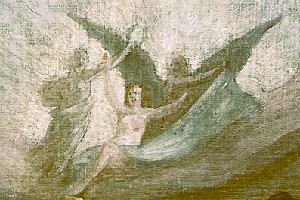
Based on an overall interpretation of Juglaris’s ceiling study, Galerie Emeric Hahn has not inappropriately entitled it The Glorification of America. In the upper right quadrant, an allegorical Fortune is exalted, rising into the heavens. Holding a small golden globe in her right hand, suggesting a desired mastery of the world, she—in keeping with highly traditional iconography—has one foot on a large ball, reminding us that human fortune can go in any direction. However, the figure of Fortune does not attain her supernal heights alone. She is flanked by a wraith-like ancient Father Time (left), symbolizing the wisdom of the ages, and a winged child or youth (right), reflecting vitality and future promise. Also rising, but from the left center of the entire mural schema, is a winged personification of Glory. Blowing a long trumpet, she carries a palm branch in hand--victory’s symbol. Most appropriately, Glory is closely followed by a pair of air-borne putti bearing laurel crowns.
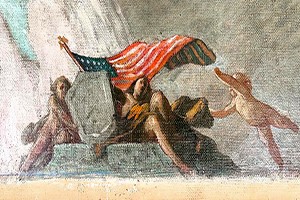
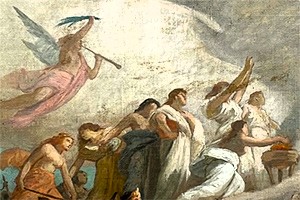
Meanwhile, importantly poised at the top center edge of the whole ceiling scene, albeit upside down from the perspective of all other depicted figures, are a pair of female figures joined by yet another flying cherub. Besides wielding a protective shield, they patriotically wave an unfurled American flag from their perched redoubt, underscoring that it is the fortunes of the United States being allegorically celebrated by the entire ceiling mural.
Halfway below at far right gathers a larger cluster of almost a dozen semi-supine spectators observing Fortune’s ascension with many upraising goblets in a toast. Simultaneously, another group congregates in the lower center of the ceiling mural on a mount, honoring Fortune and, presumably, the American nation, with a burnt offering. At the edge of this entourage stand several men. One, almost enveloped in a billowing white sheet that may have recently been pulled back to unveil and first reveal a pre-ascendant Fortune, holds a book representing Law. A second carries a sundial symbolizing Time. A third figure, bearded and bare-chested, has all the appearance of a youthful warrior, but, conjuring the Biblical image of “swords into plowshares,” carries a pruning rod--likely itself a prophecy of a fruitful and prosperous Peace.
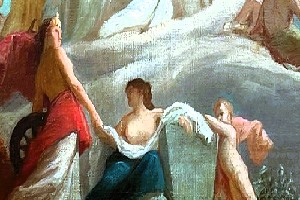
On a still lower hillock at the center of the bottom edge of the ceiling mural schema are two women, attended by another cherub. One woman partially draped in red has a wheel at her side, traditionally signifying Labor. Her companion, differently draped in turquoise, is bare-breasted, identifying her as Truth—as in the “naked truth.” She sits next to a foundation stone, suggesting that what she personifies is fundamental and foundational. Alternatively, underscoring the nature of Truth, the block may be none other than a much-fabled “philosopher’s stone,” capable of alchemically transmuting what is base into precious silver and gold. Assisted by the cherub, the women hold the lengths of a winding cloth reminiscent of the shroud which Ulyssee’s wife, Penelope, with wits and cunning so persistently sewed to keep unwanted suitors at bay until her long-absent husband finally returned. In fact, hard work, truthfulness, cunning can all serve a nation well, metaphorically weaving the fabric of a positive and productive future.
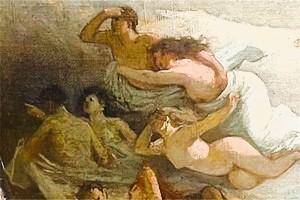
In the face of such dedicated virtues, eight mostly nude male and female figures in the lower left quadrant, representing all that is evil, malevolent, or disreputable, flee the scene, leaving behind a more pure and undiluted Fortune for the American nation crowned with Glory.
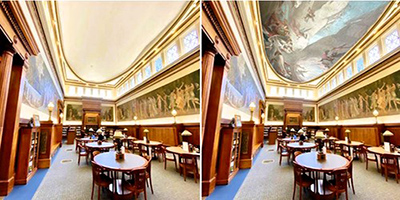
Undoubtedly, Juglaris’s own breach with fellow artist and project coordinator Henry Hammond Gallison over the final decorations for the Franklin Public Library foreclosed any possibility of executing the contemplated ceiling mural for the reading room. However, the sheer ambitiousness of the mural design may have been its own disincentive. Due to the size limits of the loomed canvases he usually preferred and the width and breadth of the reading room ceiling, Juglaris might have been required to work alfresco—applying his paints directly onto the plaster from high scaffolding—which would certainly have been more complicated and challenging for an artist like himself of advancing years.
Significantly, Juglaris’s personal memoirs neither mention any proposed ceiling work for the Franklin Public Library, nor register disappointment or frustration over an incomplete commission. While the kind of ceiling mural which Juglaris apparently contemplated may have brought heightened bravura and further context to the library’s reading room setting, more fully Americanizing it, Juglaris’s Grecian Festival murals remain complete even as they are, continuing to awe and inspire new generations of Franklin Library patrons.